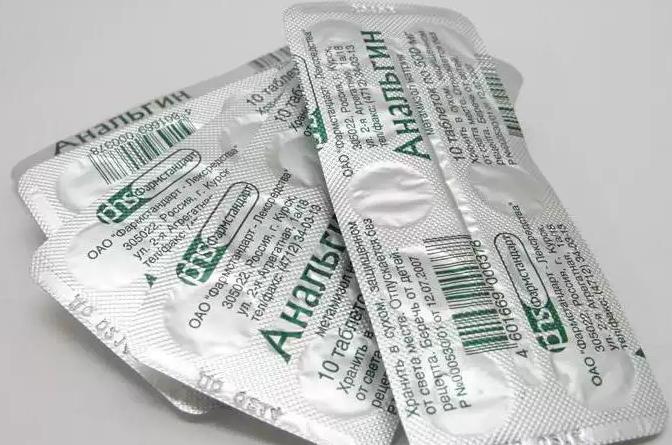Surely everyone knows such a medicine as “Analgin”. The composition of the drug, its release form and features are presented below. Also in the materials of this article you will find detailed instructions on the use of the medication in question.
Forms of release of the drug and their composition
What does a medicine like Analgin contain? The composition of the product mentioned depends on its release form. Two forms of the drug in question are most popular among patients. Let's look at them in more detail.
- The composition of "Analgin" in tablets is as follows: this medicine contains as an active ingredient. As for auxiliary components, they are presented in the form of potato starch, sugar, calcium stearate and talc.
The drug in tablet form has a white or slightly yellowish color, as well as a scored, chamfered, flat-cylindrical shape and a bitter taste. The product in question is sold in cell or non-cell packaging.
- The composition of "Analgin" in ampoules is as follows: the drug contains metamizole sodium as the main substance, and water for injection as an auxiliary substance.
This product is a transparent yellowish liquid, which is contained in ampoules and paper boxes, respectively.
Pharmacology
The drug "Analgin", the composition of which was presented above, is a non-steroidal anti-inflammatory drug, as well as a pyrazolone derivative. In terms of its mechanism of action, this medicine is practically no different from other NSAIDs. It is able to non-selectively block COX and reduce the formation of prostaglandins from arachidonic acid. 
This medication prevents the transmission of proprio- and extrareceptive, as well as pain impulses through the Burdach and Gaulle bundles. It increases heat transfer and increases the threshold of excitability of the centers (thalamic) of pain sensitivity.
A distinctive feature of this remedy is the slight anti-inflammatory effect, which causes a weak effect on the gastrointestinal mucosa and water-salt metabolism.
What other properties are inherent in the medicine "Analgin"? The composition of this medication is such that it has an antipyretic, analgesic and even a slight antispasmodic effect, including on the smooth muscles of the biliary and urinary tract.
Indications for taking tablets
This drug is used for pain of various origins, namely:

Indications for use of the injection solution
This form of the drug is also used to eliminate febrile syndrome (including infectious and inflammatory diseases, bites of insects such as mosquitoes, gadflies, bees, post-transfusion complications).
In addition, analgin injection is prescribed for pain syndromes of moderate and mild severity:
- neuralgia, arthralgia, myalgia, biliary colic;
- herpes zoster, renal colic, burns;
- intestinal colic, headache, injury;
- orchitis, myositis, radiculitis, postoperative pain;
- toothache, algodismenorrhea and others.
Contraindications for the medication
The drug in tablets is not prescribed for:
- bronchial asthma;
- hypersensitivity;
- "aspirin asthma";
- bronchospasms;
- inhibition of hematopoiesis;
- blood diseases and so on.
As for the solution, it is not used in the first three months of life, for kidney diseases, anemia, leukopenia, pregnancy, etc. ![]()
Method of using tablets
How should I use Analgin tablets (their composition was presented above)? This drug is prescribed orally in the amount of one piece twice a day after meals. The maximum single dosage is 1 g, and the daily dosage is 3 g.
When using the medicine (more than one week), constant monitoring of the working condition of the liver and peripheral blood picture is necessary.
For children, this drug is prescribed 5-10 mg per kg of body weight three times a day for no more than three days in a row (the tablet is pre-crushed).
The medicine in question cannot be used as an antipyretic for more than three days, and as an analgesic for more than 5 days.
Method of using the solution
Medical alcohol, Analgin, iodine (the composition of these products can be found in the instructions) should always be present in the home medicine cabinet.
The drug in question is administered in ampoules intravenously or intramuscularly for very severe pain.
For children, this drug is prescribed at a rate of 5-10 mg per kg of body weight twice a day. For babies under one year of age, the drug is administered intramuscularly, no more than three days in a row. 
The injected solution must have the same temperature as the patient's body.
Dosages above 1 g must be administered intravenously.
Side effects
The drug "Analgin" can cause:
- renal dysfunction, oliguria, proteinuria, anuria, interstitial nephritis;
- agranulocytosis, red staining of urine, leukopenia, Quincke's edema, thrombocytopenia;
- allergic reactions, malignant exudative erythema, bronchospastic syndrome, decreased blood pressure;
- infiltrates at the injection site.


